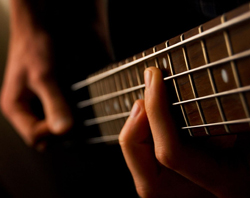
4) The bass usually speaks best if any low end added is about an octave above the kick, so if the kick was EQ’d at 60 Hz, then try boosting at 120 Hz first.
Keep in mind that it might sound better at 100 or 150 Hz instead, depending upon the instrument, the song, the arrangement and the player, so try all those frequencies before you settle on one.
Remember that you should be listening to the drums at the same time you’re EQ’ing the bass.
One of the problems that inexperienced mixers have is that they boost the very low frequencies (40-60 Hz) of the bass first, which only muddies things up and makes it disappear on small speakers.
A solid round low end with better definition usually comes from 100Hz upward.
5) For more definition on the bass, add a little 700 Hz or so, or at the exact frequency that you dipped the kick drum.
6) For some snap or buzz, add some 1 to 3 kHz on the bass.
7) Make sure than any frequencies that you boost on the snare haven’t already been boosted on the kick and bass. 125 Hz gives it some bottom, but if the bass is already boosted there you have to go a little higher or lower (usually higher) to make it fit.
Add some 1 to 2 kHz for attack and 10 kHz for some snap.
8) Sometimes it sounds better on a song if the frequencies of the kick and bass are reversed, with the bass getting boosted at 50 to 60 Hz and the kick an octave or so above it.
A little juggling of these frequencies should give you a great drum and bass blend.
You can find a lot more on recording and mixing bass and drum sounds in The Mixing Engineer’s Handbook and The Recording Engineer’s Handbook.
Bobby Owsinski is an author, producer, music industry veteran and technical consultant who has written numerous books covering all aspects of audio recording. For more information be sure to check out his website and blog.
